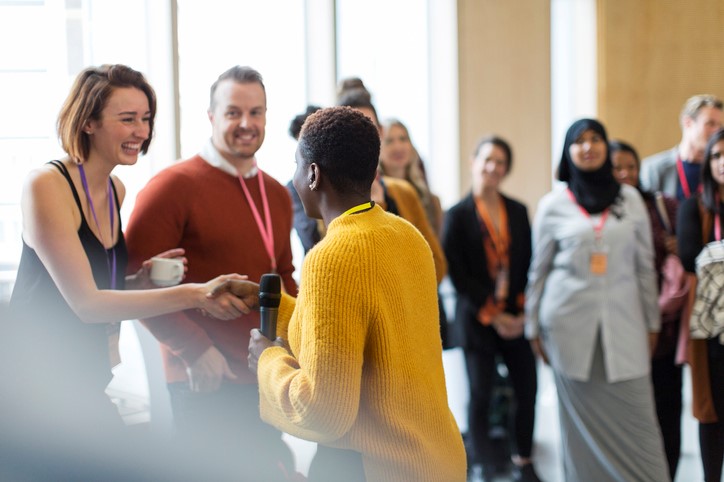Kimberly Richardson describes herself as funny, thoughtful and a visionary, all traits she deems necessary to perform her duties as assistant city manager for Peoria, Illinois. She had a calling to work in government from an early age to implement necessary and lasting change, but working in government during the COVID-19 pandemic taught her we could all be creative and innovative in our response to issues in the community.
A Common Shared Value
According to Richardson, "leading with purpose" means understanding that we’re all neighbors and have to take care of each other. She says, “We all have a shared value. Our shared value is to have a community [of] people feel safe. That people have a life expectancy that’s higher than what the average can be considering where you work or live, and that people feel that they are part of a bigger good. That’s what employees want too. That is a shared value.”
Humans cannot thrive without community. Being part of a community means it’s not about "I"; it’s about "we." Richardson explains, “That is the glue that is able to bond everything else. The ‘we’ of the community is the glue.”
Being part of a "we" extends to the work that local government employees perform. “Even though you may not feel like you’re being seen, someone is seeing that, and someone is appreciating that work," Richardson says. "And that, to me, is always what makes me feel really good about what we do. It’s a thankless job at times, but someone sees it, and someone is going to respond to it.”
Government officials may find work particularly difficult when they have limited power and countless residents who want to feel heard. Yet Richardson has started to notice something in her own community: “What they say to me consistently is, ‘Thank you for listening. Thank you for your time and [for] not rushing me off the phone.’ I think that’s impactful. It may only impact that person. But it has an impact, and I think that’s important.” Leaders are going to deal with challenging situations at times, but according to Richardson, “We have to realize what our purpose is, to begin with.”
How Purpose Affects Decision-Making
Leading with purpose impacts Richardson’s decision-making every day. She says, “Leading with purpose is something where you are intentionally making decisions that are going to have a positive impact on your organization, organizational culture and the community as a whole.” When leading with purpose, one must also lead with intention. One thing Richardson repeatedly tells her staff is, “I’d rather measure twice and cut once.” Not only does she liken leading with purpose to having intention, she believes that if you are not listening, you are not leading with intention.
Leading with purpose informed Richardson's response to the pandemic. “I think what COVID-19 has taught us is that we can be responsive, we can be creative, innovative, and we can do it in a way that is not only for the benefit of our residents and community members but for the organization as a whole. I think [during the pandemic], especially here in the U.S. if you’re not going to listen as a leader, you’re not leading with intention,” she said.
What Is Your "Why"?
Richardson always felt a need to work in government. This instinct has kept her motivated all these years, and she recognizes this drive as a generational feeling, saying, “Just like every other millennial, we all want to have some change in the world.”
When asked to advise those who wish to have a more purposeful, driven leadership style, she said, “They need to recognize what's their why? Why do they see themselves as a leader? Because I tell people a leader and a manager are not the same.” She continues, “To me, a title does not make one a leader. A title just tells you where they sit in the organization. A leader can be anywhere in the organization, as long as people follow and respect you. And you come to the community. You come to that organization with good intentions.”
In this world today, everything is moving so fast. It’s okay to slow down. It’s okay to deliberate. It’s okay to say, 'you know we don’t have all the answers.' We don’t need to sometimes have all the answers, and that’s something we’re missing.
— Kimberly Richardson
The Next Generation of Purpose-Driven Leaders
Modern governance tools help Richardson lead with purpose more effectively by allowing her to participate in good conversations, and to listen and ask questions as a leader. She says, “I tell people sometimes to be a good leader, you just have to ask a lot of questions.” When asked whether or not courage is required to lead with purpose, she said, “[It] doesn’t take courage to lead with purpose. Those who lead with purpose are intentional, and they know why they’re leading.”
Representation needs to be of the highest importance to create the next generation of leaders. If we fail to bring representation to governments at every level, we’re doomed to repeat the same bad policy decisions that we’ve made. Richardson believes that “if we don’t lead with intentionality, and if we don’t bring in youth as part of that process, we’re going to lose a generation of next leaders.”
Luckily, she believes that people now want to be involved in governance, and there is a growing hunger for community members to feel they’re part of the solution. The challenge will be deciding how to appropriately incorporate those new voices, a job Kimberly Richardson was born to do.
Is it time to reconnect with your "Why?" Our free workbook will guide you through the steps to discover, or rediscover, the reason you lead with purpose every day.




